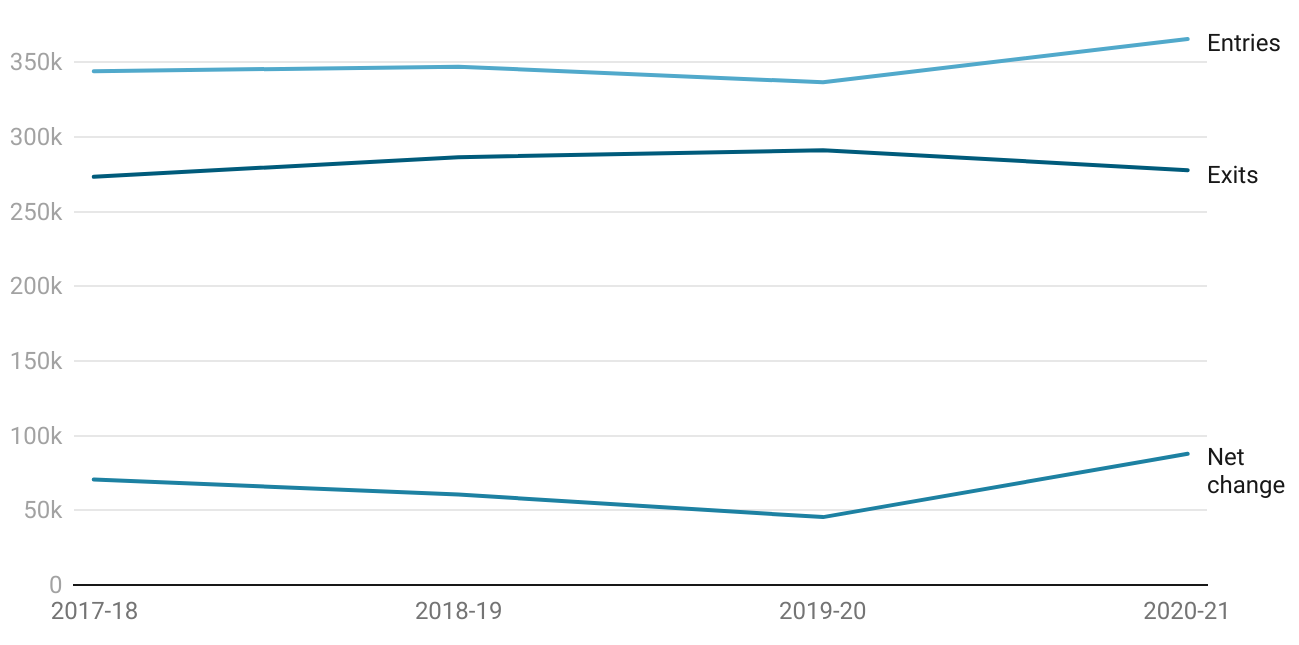Business insolvency rates show post-Jobkeeper fallout yet to emerge
Australia is not yet seeing the level of business insolvency rates predicted for when Jobkeeper and other support measures came to an end
The Australian Bureau of Statistic (ABS) recently released numbers showing counts of actively trading businesses has risen by 3.8 percent between 2020 and 2021, with 87,806 more businesses that the 2019-20 period. This comes after a year with lower numbers of businesses entering external administration than usual. Australian Securities and Investments Commission (ASIC) recently reported that 2020-21, 4235 companies entered external administration. This was after 7362 in 2019-20, and 8105 the year before that.
Business entries and exits, 2017-18 to 2020-21, Australia

The new ABS data saw a 12 per cent exit rate of businesses 2020-21, down slightly from 12.5 per cent the year before. Dr Pamela Hanrahan, Professor of Commercial Law and Regulation in the School of Management and Governance at UNSW Business School, says these stable numbers show we are not seeing the wave of business closures some predicted when government measures like the JobKeeper program and suspension of Australia’s insolvent trading laws – aimed at supporting businesses – ended.
“The reasons for this might be complicated,” she says. “It may be that some businesses affected by COVID-19 lockdowns and related factors are limping on for now, in hope that government and creditor support continues.”
Anil Hargovan, Associate Professor in the School of Management and Governance at UNSW Business School agrees, adding that the static exit numbers continue to reflect the impact of earlier protective measures in forestalling business closures.
“It’s also important to remember that while COVID-19 has had an impact on businesses, it hasn’t been evenly spread,” A/Prof. Hargovan says. “Some sectors of the economy are doing extremely well.”

Did JobKeeper affect the levels of insolvencies?
Government measures like JobKeeper and a suspension of insolvent trading laws were instrumental in suppressing or forestalling insolvencies, not just in viable companies, but those that were undercapitalised, had endemic cash flow difficulties, or poor management practices, explains A/Prof Hargovan. But he says that it is hard to pinpoint exact effects.
“There’s been little transparency surrounding the government’s administration of JobKeeper, meaning we don’t really know how many businesses were propped up, making it difficult to assess.”
While the emergency support program ended as of March 2021, A/Prof. Hargovan believes we are yet to see the full result of any fallout. “There might be a time lag between the economic crisis and peak insolvency numbers as foreshadowed by the Australian Financial Security Authority (AFSA),” says A/Prof. Hargovan. “History shows us that you can expect at least a four-year gap between crisis and impact.”
Prof. Hanrahan agrees, adding that the recent ABS numbers won’t fully show the results of Sydney or wider-NSW lockdown. “Does that mean we’ve dodged a bullet in terms of business insolvencies?” she says. “No. But I think we’ve kicked the can down the road a bit.”

Abandoned shop fronts and 'zombie businesses'
There are also the stories behind the numbers, like small business owners who have simply walked away, or ‘zombie businesses’ who were being kept afloat by shielding measures like stimulus programs.
A/Prof. Hargovan says he expects a significant number of zombie businesses (companies that are no longer viable but have not yet been restructured or closed) to be exposed to the full brunt of insolvency law over time, now that protective measures have been removed. “These expectations are subject to insolvency professionals and regulators being vigilant in rooting out Phoenix activities (when companies transfer assets from a debt-ridden company to a new company, meaning old debts cannot be covered), which may have been amplified by the blanket suspension of insolvent trading laws.”
There are also the SMEs who have not declared official insolvency. At a recent roundtable on business support and corporate insolvency, hosted by CPA Australia and chaired by Prof. Hanrahan, industry experts expressed concern that in sectors like hospitality, the prevailing view was to simply ‘shut the door and walk away’. “Small businesses are less likely to engage with an adviser or insolvency practitioner” she says. “Without engaging in any formal insolvency processes or accessing the expertise in the way large companies do, they go straight into liquidation initiated by a major creditor like the Tax Office.”
Read more: Australia's unemployment rate hits decade low amid lockdown gloom
Under Australian law, if the directors of a company that is insolvent allow it to continue trade, they become personally liable for its debts, says Prof. Hanrahan. As a result, there’s significant incentive to call in insolvency practitioners, and to either restructure or wind up.
In March 2020, the government temporarily altered some aspects of the corporate insolvency laws, and companies were given more time to meet statutory demands from creditors, the statutory minimum amount to issue a statutory demand was increased from $2000 to $20,000 and directors’ personal liability for insolvent trading was modified. “That changed back in 2021 to the pre-pandemic settings,” adds Prof. Hanrahan. “Which people need to be aware of.”
How can small businesses recover?
These challenges for SMEs have been compounded by limits in the insolvency law reform passed in January 2021, says A/Prof. Hargovan. He says the issue is that its details are in complex regulations, not easily accessible or digestible by the layperson. “Also, the access to these new rescue laws only applies to businesses with a debt of a million dollars,” he adds.

“That cap is too low, given that many directors of small business give out personal guarantees. This has been a missed opportunity by the government in making the new rescue laws more accessible to small businesses.” The government is now overhauling these laws, just months after substantial reforms were introduced.
Despite these hurdles to small businesses, Prof. Hanrahan encourages those struggling to not despair and find out all their options before heading straight into liquidation. “Get proper advice and make sure you access reputable information to give your business the best chance of surviving.”
Should businesses be allowed to fail at this point?
In a capitalist system, it is a normal practice for businesses to fail. It’s unpleasant, says Prof. Hanrahan, but not always a bad thing. It’s a cycle that plays a key role in the market economy and the state of innovation. “If you see the system starting to atrophy, then the bigger worry is what alternatives are people not moving forward with; by closing off something that would have failed anyway, and starting something new,” she points out.

“I worry about what it’s doing to the innovation pipeline, and that you’re not getting that capital cycling around the economy and funding new ideas. This will just compound that.”
On the other hand, large numbers of small businesses failing at once could have devastating consequences through the ripple effects of insolvency. “History shows that it often results in dislocation of communities through high unemployment,” says A/Prof. Hargovan. “And it has an impact on other businesses through supply chains.”
But will the government let a swathe of small businesses fall into insolvency? “If they keep propping them up between now and the election, how bad is that going to be afterwards?” says Prof. Hanrahan. “I think it’s very unlikely that they will let thousands of small businesses – a contingent that is their voter base – go broke.”
“But JobKeeper resulted in a very significant amount of money being given to businesses that didn’t need it. And they’re anxious not to repeat that error.”
